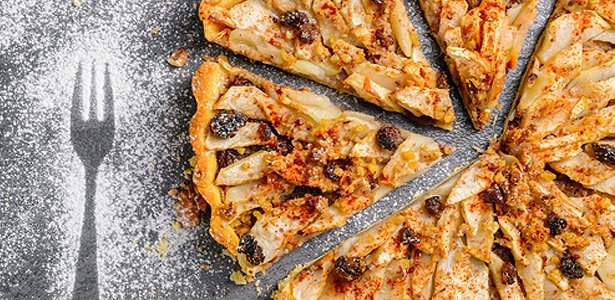Puff pastry (Prince William)
If there were a king of pastries, puff pastry would be it. Rich, attractive and able to rise to great heights. Created by repeatedly rolling the pastry out and folding it up again, each roll and fold creates more layers which help it to rise. Equal parts butter to flour make it the richest pastry of all, but beware of cheap vegetable shortening substitutes. They can give it a waxy feel. In a good puff the layers should be deliciously crispy not soggy and greasy. It’s used for pies, mille feuille (custard slices), vol-au-vents (little pastry cases for canapés), palmiers (pig ears) and tarte tatin.
Rough-puff pastry (Prince Harry)
Also rich and delicious, but a little more accessible to the masses. Rough puff has slightly less butter content (two thirds fat to flour) but it is no less delicious. It also requires rolling and folding to create the layers, but making the dough is a lot simpler which is why it’s most people’s choice. It can be used in all the same ways as puff pastry
Short crust pastry (Queen Elizabeth II)
A household name for sure and curiously down to earth. With only half butter to flour, short crust pastry has been used for centuries to make quiches, pies and tarts. Most often blind baked before filling to prevent the dreaded soggy bottom. It can be used in sweet or savoury pies, quiches and tarts.
Pâte sucrée – sweet short crust (Prince George)
Adorable, charming and sweetly delightful. From the same family as the short crust but with sugar and egg yolk added. It can be a little hard to handle (a bit like a toddler), and may also need blind baking. It’s used in sweet tarts like lemon tart and fruit tarts
Choux pastry (Kate Middleton)
Elegant, classy and timelessly fashionable. The name actually means ‘cabbage’ in French because a row of profiteroles resembles cabbages in the field. Made by heating butter and water and adding to flour to form a roux, then adding eggs. It differs from other pastries as it is piped not rolled. It can be used for éclairs, profiteroles, the French wedding cake called a Croquembouche, or savoury, cheesy dishes called gougere.
Phyllo pastry (Prince Charles)
This is a pastry of many layers. Many, many layers. Phyllo pastry is made without fat and stretched into thin layers where the gluten in the flour allows it to be rolled paper thin. The fat is added by brushing melted butter onto the layers before baking. The final product should be crunchy, and buttery. It’s used mostly in Greek and Middle Eastern dishes like baklava and spanakopita.
Hot water crust (the Duke of Edinburgh)
Crust, very crusty, and a little old-fashioned. Not often in the spotlight and considered quite old-fashioned, the hot water crust is made by boiling water with the butter or lard and mixing it into the flour. The resulting slightly sticky dough is then hand shaped by pushing it into a mould or pudding bowl. It’s used in traditional pork and game pies.

